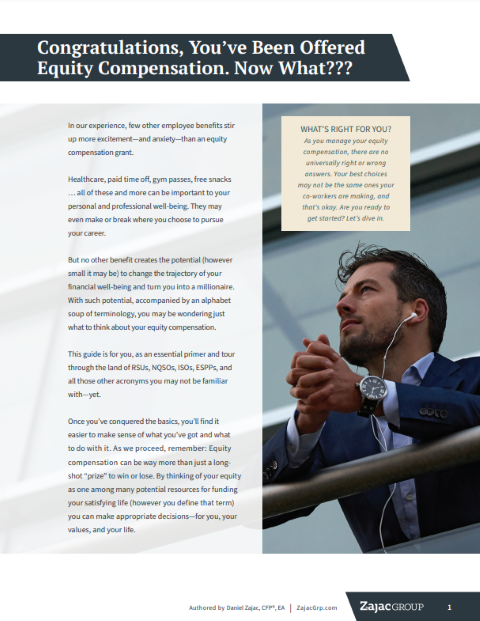A new year can be an opportune time to review your equity compensation package. Not only does this give you a clean slate to work with, but it also affords you the most time to plan and implement your strategy for the fresh calendar year ahead.
When it comes to annual planning for your equity compensation, you’ll want to consider a number of items. To get started, you might want to ask (and get answers to) questions like:
- What type of equity compensation do I own?
- What are the tax implications of what I have?
- Should I continue to hold shares that I own, or should I sell and diversify my portfolio?
- How do the actions and decisions I’m considering fit into my overall financial plan?
You’ll likely have other questions too. But these are some of the commonly asked ones and provide a good place for you to start. Once you have some of the answers, you can begin to develop a plan that works for you.
To further help you with the planning you should do for your equity compensation in the new year, use this list of 8 steps you can take to best position yourself to create a smart strategy.
1 – Review What Occurred with Your Equity Compensation Last Year
The beginning of the year is a great time to review what you accomplished in the previous year. It’s also a is a good time for a gut check and self-reflection on your equity compensation plan and how well you are using it to achieve your goals and objectives.
One way to test your success is to evaluate your plan, and review how well (or not) you stuck to that plan during the previous year. If you struggled to execute or implement your strategy, it might be a smart move to reach out to a financial advisor to help you and hold you accountable for the actions you need to take.
GET THIS GUIDE
When it comes to your finances, it's important to understand what you have, what you should consider, and how it can impact your personal goals. This guide is the best place to start.
2 – Determine If You Have Stock Options or Restricted Stock Units That Vest This Year
If you have equity compensation that is set to vest this coming year, pay close attention to the details around these events. You will likely need to make a number of decisions about what to do with these shares once vested.
If you have restricted stock units, their value will be taxed as ordinary income. You’ll want to include this income in your tax and cash flow planning. You’ll also want to plan the next step for your vested RSUs.
One option might be to retain vested RSU shares post vesting in hopes the stock price will go up in value. A second option might be to sell shares immediately and redirect the proceeds into something else (like contributing to a savings goal, paying down debt, or allocating the funds into a more diversified portfolio).
If you have incentive stock options or non-qualified stock options, vesting will have no immediate impact on your tax return. Vesting simply gives you the right to act upon the option, not the obligation to do so.
But knowing that you’ll soon have that right once your shares vest, now is the ideal time to review your exercise and sell strategy.
If your stock options are deep in the money, meaning the fair market value of the stock is significantly higher than the exercise price, you may want to consider capturing that value. This may mean an exercise and sell of some (or all) shares. Otherwise, you may choose to keep your options as is and wait to exercise them.
The decision to exercise, hold, and sell your incentive stock options and non-qualified stock options is complicated. You should consider how your options are taxed (ISOs and NSOs are taxed differently), how it may impact your cash flow (by asking questions like, can you afford the cost of exercising?), and how it impacts your financial plan.
3 – Check for Equity Compensation That May Expire Soon
It’s important to periodically review the expiration date of your incentive and non-qualified stock options. If the options are set to expire this year and they’re in-the-money, exercising them before that expiration date might be a good choice.
If you don’t exercise the options before they expire, you lose any embedded value of the option. If you do exercise, you’ll want to consider a few things, including but not limited to:
- When during the calendar year you want to exercise?
- What are the tax implications if you choose to exercise?
- How does an exercise of stock options impact your cash flow?
- What will you do with the shares that you can exercise? Keep them, sell them, or sell some and keep others?
It also makes sense to take note of shares that are set to expire in the next year or two, because exercising now could be a better move than waiting until the last minute.
That’s not always the case, but this is why it’s wise to investigate now so you have time to make decisions and act accordingly. There’s no one “right” answer that applies in every situation, and you may need to do a detailed analysis of your personal plan to determine what might be best for you.
4 – Determine If You’ll Have a Qualifying Disposition with Any ISOs or ESPP Shares
A qualifying disposition of incentive stock options is one in which the final sale occurs at least 2 years from the grant date and 1 year from the exercise date of the option. If you have shares that are set to meet this requirement this year, you should identify them and create a plan.
These shares are especially important because the full gain from the exercise price of the stock to the final sale price is taxed as a long-term capital gain. They may also be advantageous when it comes to getting an AMT credit.
If you have employee stock purchase plan shares that meet the rules for a qualifying disposition, you may want to evaluate what to do next with these, too. Meeting the requirement may allow you to benefit from long-term capital gains tax rates on the majority of the proceeds of the sale.
(Note that the rules around this can get a bit nuanced, so you’ll want to read this to make sure you understand them first.)
The beginning of the year is a good time to identify newly-minted qualifying shares, as well as qualifying shares from previous years that have not been sold. Once identified, you can further consider a plan for exactly what to do with these shares.
5 – Develop a Strategy to Exercise Some (or All) Shares
The beginning of the year can be a good time to exercise some of your shares from vested incentive stock options. An exercise early in the year may allow you to best manage your cash flow and give you the opportunity to see how the stock performs prior to locking in a single tax event.
Taxes triggered by exercising, holding, and later selling incentive stock options are not due until tax filing time in the year following the year of exercise. You may be able to exercise your shares, hold them for 1 year, sell them, and use the proceeds to pay the pending tax — all as a qualifying disposition.
An early in the calendar year exercise may also allow you to better manage the alternative minimum tax. If the stock price increases between the exercise date and the end of the year, you may want to keep the stock to reap the benefits of long-term capital gains rates.
If the stock price decreases, however, selling your ISO shares in a disqualifying disposition may make more sense. A disqualifying disposition in the same calendar year will eliminate the AMT adjustment for the calendar year, removing some of the impacts of paying the AMT.
Note that this will cause the gains (if any) to be taxed at ordinary income rates, but the proceeds of the sale will be available to pay the requisite tax due. This can help make it easier to manage the cash flow aspects of the transaction.
6 – Review and Adjust for New Grants Received
If you’re on the receiving end of new restricted stock units or other employee stock options, you’ll want to consider how these fit into your plan.
To start the process of integrating newly issued grants into the plan, you’ll want to consider what type of grant it is, when the grant vests, and how it will be taxed (amongst other things).
With that key information, you can begin to fit the new grants into your strategic and tactical decision making.
7 – Review and Plan for Estimated Taxes
Now is also a good time to complete a review of your expected tax return. Once the previous year is over, you can be certain of your transactions and make a final estimate of what your income tax liability (or refund) may be.
The tax implications of dealing with equity compensation will depend on the types of compensation you have, whether or not you exercised and sold shares, or had shares vest.
For example, restricted stock units and non-qualified stock options are likely subject to ordinary income, Medicare, and Social Security taxes. Income taxes may also be withheld on RSUs when they vest (and the same happens with exercised NQSOs) through a cashless transaction or a share withholding by your company.
This withholding may help alleviate a potential tax burden down the road, but the forced withholding may or may not be enough to cover your total tax need. You need to run your own numbers to confirm enough taxes were held back, and if not, plan to set aside some cash to pay what is still owed.
If you have incentive stock or ESPP shares, taxes probably won’t be withheld at all. In this case, you’ll need to plan for estimated tax payments or for a larger tax bill next spring.
Complicated tax rules are one reason why you may want to consider your overall financial and tax plan before you exercise or sell your shares. An uninformed employee who decides to exercise may create a tax liability that is bigger than they can actually afford. Being aware of cash flow when you exercise your options is a critical part of the conversation.
8 – See If You Are on Track to Meet Your Goals
Equity compensation can be a fantastic way to increase your wealth — but it also means handling an increased responsibility to understand how your equity compensation works, how it is taxed, and how to make the best decisions with this potential tool for growing wealth at an exponential rate.
The new year is a great time to review how your equity compensation is (or isn’t) helping your reach your financial goals. These could include preparing for retirement, buying a new home, funding college tuition, and so on.
Part of this review includes an honest assessment of what your goals may be. Is your primary goal to minimize the amount of tax you pay on your equity compensation? Or is your goal to grow your account balance so high that you amass generational wealth?
Another goal may be to use your equity compensation to set a reasonable financial goal that targets financial freedom, or perhaps you’re working on controlling your cash flow and have past debts that you need to repay.
Whatever your specific goals and values are, now is a good time to evaluate how close you are to achieving what’s most important to you.
And if you’ve “made it,” it may make sense to consider what risk you retain by keeping shares of a single stock. Typically, a single stock brings with it a more volatile position as compared to a more diversified portfolio. You may run the risk that you go from “made it” to “not there yet” should the stock price drop.
To best set yourself up for success, it takes a combination of understanding the tactical aspects regarding what types of equity you own, what the rules of the plan may be, how said compensation is taxed, and how it will impact your cash flow.
These details should be integrated into a strategic financial plan that is targeted towards meeting your personal goals and objectives.











0 Comments